The inorganic world is simple compared to the organic world. There is not one of the great physical agents, electricity, magnetism, heat, light, or chemical affinity, which exhibits in its sphere as complicated phenomena as the simplest organized beings. When then organized beings include everything the material world contains and a great deal more that is peculiarly their own, how could they be produced by physical causes, and how can the physicists, who acknowledge that these laws must have been established at the beginning, overlook the laws which regulate the organic world, the existence of which there is no trace for a long period upon the surface of the earth, and must have been established later and successively at the time of the creation of the successive types of animals and plants?
4. Jehovih caused the jelly fish and the green scum of water to be permanently coming forth in all ages, that man might understand the age of se'mu, when the earth and the shores by the water, and the waters also, were covered over with commingled atmosphere and corporeal substance. And this substance was called se'mu, because by Jehovih's presence quickened He it into life, and thus made He all the living, both the vegetable and animal worlds. Not that se'mu is jelly-fish or the green scum of water; for the earth in this day produceth not se'mu abundantly; nevertheless the jelly-fish and the green scum of water are signs of that which was in that day of the earth.You might wonder how could man be made out of se'mu. What has 'green scum of water' or algae got in common with the flesh and blood of Man's forefather?Book of Jehovih Ch V
10. To the tree I gave life; to man I gave life and spirit also. And the spirit I made was separate from the corporeal life.
11. Out of se'mu I made man, and man was but as a tree, but dwelling in ha'k; and I called him Asu (Adam).The Voice Of Man Ch VI
But Oahspe also says:
13. Man sought to know the progress of things. Jehovih answered him, saying:
14. There is a time of childhood, a time of genesis, a time of old age, and a time of death to all men. Even so is it with all the corporeal worlds I have created.
15. First as vapor the vortex carrieth it forth, and as it condenseth, its friction engendereth heat, and it is molten, becoming as a globe of fire in heaven. Then it taketh its place as a new born world, and I set it in the orbit prepared for it.
16. In the next age I bring it into se'mu, for it is ripe for the bringing forth of living creatures; and I bestow the vegetable and animal kingdoms.
17. Next it entereth ho'tu, for it is past the age of begetting, even as the living who are in dotage. Next it entereth a'du, and nothing can generate upon it. Then cometh uz, and it is spirited away into unseen realms. Thus create I, and thus dissipate planets, suns, moons and stars.
18. My examples are before all men. My witnesses are without number. I rise the tree up out of the ground; I give it a time to bring forth fruit; and then barrenness, and then death and dissolution. I prepare the new field with rich soil, bringing forth; and the old field that is exhausted, and man shall weigh the progress and destiny of a whole world.
19. Let no man marvel because of the size of the mammoth and the ichthyosaurus, for there was a time for them as there is a time for the infusoria of this day.
20. I have given thee a sign, O man, in the queen of the honey bee; because of the change of the cell cometh she forth a queen, even from the same manner of germ as the other bees. Be wise, therefore, and remember that the earth is not in the place of the firmament as of old. Let this be a testimony to thee of the growth, the change and the travail of the earth.
21. Nevertheless, O man, the seen and the unseen are but parts of My person; I am the Unity of the whole.
Oahspe uses 'progress of things' instead of 'evolution' because living things didn’t evolve but were created in the Se'muan age. I don’t say this in the 'creationist' sense, but that a fully aware apparently silent and hidden 'All Knowledge, All Person', by His presence, brought the elements together, according to His own everlasting times and seasons.
5. Jehovih said: Because of My presence quickened I into life all that live, or ever have lived.
6. Because I am male and female, even in my likeness, thus made I them. Because I am the power to quicken into life, so, in likeness of Me thus, made I them, and with power to bring forth.
8. According to their respective places and the light upon se'mu, so quickened I them in their color, adapted to their dwelling places.
9. Each and every living thing created I new upon the earth, of a kind each to itself; and not one living thing created I out of another.
10. Let a sign be upon the earth, that man in his darkness may not believe that one animal changeth and becometh another.
11. Thereupon Jehovih gave permission for different animals to bring forth a new living animal, which should be unlike either its mother or father, but he caused the new product to be barren.
12. Jehovih said: And this shall be testimony before all men that I created each and all the living, after their own kind only.
13. Such is My person and My spirit, being from everlasting to everlasting; and when I bring a new world into the time of se'mu, lo and behold my presence quickeneth the substance into life; according to the locality and the surroundings, so do I bring forth the different species; for they are flesh of My flesh and spirit of My spirit. To themselves give I themselves; nevertheless, they are all members of My Person.
14. As a testimony to man, behold the earth was once a globe of liquid fire! Nor was there any seed thereon. But in due season I rained down se'mu on the earth; and by virtue of my presence quickened I into life all the living. Without seed created I the life that is in them.

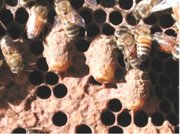
Living in the age of genetic engineering we could think that the Oahspe note about ‘change of the honey bee cell’ above refers to a gene alteration in the DNA, a cell being the container of DNA within its nucleus.
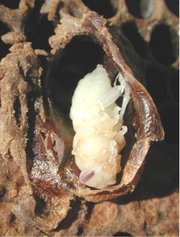
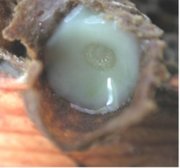
So according to wikipedia the queen bee develops unlike the worker bees as a result of the difference in diet, ignoring the different size and orientation of the specially-constructed queen cell.
By the sign of the change of the cell that causes a honey bee to come forth a queen, Oahspe is saying that it is the mould or surroundings, our going from dark regions to etheric, that is bringing global tranformation, rather than a pulling ourselves up by inherent evolutionary bootstraps. Nevertheless, there are implications in Oahspe that tie in with the current evolution paradymn, particularly the change of RNA in the earliest cells, up to our becoming this complex life form.
Infusoria is a collective term for minute aquatic creatures like ciliates, euglenoids, protozoa, and unicellular algae that exist in freshwater ponds. However, in formal classification microorganisms called infusoria belongs to Kingdom Protista.
Protists are a diverse group of organisms, comprising those eukaryotes that cannot be classified in any of the other eukaryotic kingdoms as fungi, animals, or plants. They are usually treated as the kingdom Protista. Protoctists are paraphyletic and so do not have much in common besides a relatively simple organization - either they are unicellular, or they are multicellular without highly specialized tissues.
Protists were traditionally subdivided into several groups based on similarities to the "higher" kingdoms: the one-celled animal-like protozoa, the plant-like protophyta (mostly one-celled algae), and the fungus-like slime molds and water molds. Because these groups often overlap, they have been replaced by phylogenetic-based classifications.
At one time, the non-nucleated bacteria were also considered protists under the three-kingdom system of Animalia (comprising the many-celled animals or metazoans), Plantae (which then included fungi as well as green land plants), and Protista (which included everything else, except viruses). However, most current textbooks treat bacteria (and the newly-discovered archaea) as either a separate kingdom or domain.
While there is no exact definition of 'Protozoa', most scientists use protozoan to refer to a unicellular heterotrophic protist.
Carbon metabolism in bacteria is either heterotrophic, where organic carbon compounds are used as carbon sources, or autotrophic, meaning that cellular carbon is obtained by fixing carbon dioxide. Typical autotrophic bacteria are phototrophic cyanobacteria, green sulfur-bacteria and some purple bacteria
So by associating infusoria to be behind the evolution, or rather, the progress of interconnected life forms and earth changes, Oahspe is speaking of the most simple celled units as being the building blocks of life in all phases and eras of life, just like evolutionists.
So how do these simple eukaryotic cells create so much diverse life, that dwelt symbiotically in their own identifiable eras and habitats?
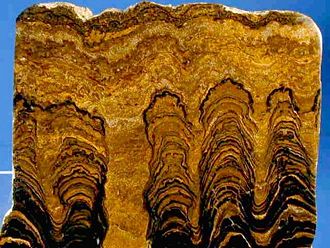
It said
"the earliest known fossils that have been found in rocks are 3.5 billion years old. These earliest fossils are called stromatolites, which are mats of blue-green algae"
See also
Stromatolites are layered accretionary structures formed in shallow water by the trapping, binding, and cementation of sedimentary grains by biofilms of microorganisms, especially cyanobacteria (commonly known as blue-green algae).
Stromatolites occur widely in the fossil record of the Precambrian, but are rare today. Very few ancient stromatolites contain fossilized microbes.
Stromatolites were much more abundant on the planet in Precambrian times [88% of the earth’s history is Precambrian]. While older, Archean fossil remains are presumed to be colonies of single-celled blue-green bacteria, younger (that is, Proterozoic) fossils may be primordial forms of the eukaryote chlorophytes (that is, green algae). The earliest stromatolite of confirmed microbial origin dates to 2,724 million years ago.

The Proterozoic geological eon (2500-542 million years ago, the most recent part of the Precambrian time) represents the period before the first abundant complex life on Earth (Cambrian period when the first fossils of trilobites and archeocyathids appeared).

The build-up of oxygen in the Earth's atmosphere happened in the Proterozoic eon, with transition to an oxygenated atmosphere during the Mesoproterozoic. Though oxygen was released by photosynthesis well back in Archean times, it could not build up to any significant degree until chemical sinks — unoxidized sulfur and iron — had been filled; until roughly 2.3 billion years ago, oxygen was probably only 1% to 2% of its current level. Banded iron formations, which provide most of the world's iron ore, were also a prominent chemical sink; most accumulation ceased after 1.9 billion years ago, either due to an increase in oxygen or a more thorough mixing of the oceanic water column. Red beds, which are colored by hematite, indicate an increase in atmospheric oxygen after 2 billion years ago; they are not found in older rocks. The oxygen build-up was probably due to two factors: a filling of the chemical sinks, and an increase in carbon burial, which sequestered organic compounds that would have otherwise been oxidized by the atmosphere.
The first advanced single-celled and multi-cellular life roughly coincides with the start of the accumulation of free oxygen; this may have been due to an increase in the oxidized nitrates that eukaryotes use, as opposed to cyanobacteria. It was also during the Proterozoic that the first symbiotic relationships between mitochondria (for nearly all eukaryotes) and chloroplasts (for plants and some protists only) and their hosts evolved. The blossoming of eukaryotes such as acritarchs did not preclude the expansion of cyanobacteria; in fact, stromatolites reached their greatest abundance and diversity during the Proterozoic, peaking roughly 1.2 billion years ago.The Ediacaran Period (635 to 542 Ma) is characterized by the evolution of abundant soft-bodied multicellular organisms.
The Proterozoic record features many strata that were laid down in extensive shallow epicontinental seas
Study of these rocks show that the eon featured massive, rapid continental accretion (unique to the Proterozoic), supercontinent cycles, and wholly-modern orogenic activity.
The first known glaciations occurred during the Proterozoic, one began shortly after the beginning of the eon, while there were at least four during the Neoproterozoic, climaxing with the Snowball Earth of the Varangian glaciation.
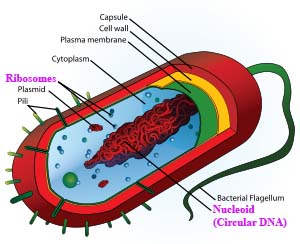
Prokaryotes are a group of organisms that lack a cell nucleus, or any other membrane-bound organelles, such as mitochondria and chloroplasts. Instead photosynthesis takes place across the prokaryotic plasma membrane. Prokaryotes differ from eukaryotes by the absence of a nucleus. Instead, the genomes of prokaryotes are held within an irregular DNA/protein complex in an area named the nucleoid, which lacks a nuclear envelope. [The genome of an organism is its whole hereditary information and is encoded in the DNA (or, for some viruses, RNA)]
Prokaryotes also differ from eukaryotes in that they contain only a single loop of stable chromosomal DNA stored in the nucleoid, while eukaryote DNA is found on tightly bound and organized chromosomes.
Both eukaryotes and prokaryotes contain large RNA/protein structures called ribosomes, which produce protein. Ribosomes must have been at the beginning of life because proteins are the building blocks of all living things.
"The sequence of DNA nucleotides in RNA varies in different organisms, and the patterns of differences reflects evolutionary change between organisms. The more of the score any two species had in common, the closer they are related on the tree of life.
The scores of plants, animals and humans are very similar. The gentic relationship of human beings and all the categoties of life are linked to each other.
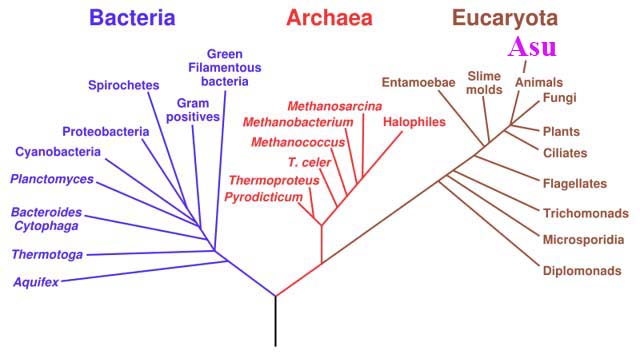
Genetic evidence suggests that eukaryotes evolved from the union of some bacteria and archaea (one becoming an organelle and the other the main cell). According to this youtube
“Microbes are at the beginning of our family tree. All living things came from the same basic blueprint. Each of us contains within our genetic material a history of life on earth. Cells like ours were born over a billion years ago by a marriage of different single celled microbes. Our cells are a combination of multiple organisms. We are composites of linages of bacteria and other organisms. We are compounding life on life."
So, in this sense "out of se'mu" Man is made, because the body of man is little different to algae, plants, animals.
Algae are a large and diverse group of simple plant-like organisms, ranging from unicellular to multicellular forms. The largest and most complex marine forms are seaweeds. They are considered "plant-like" because of their photosynthetic ability, and "simple" because they lack the distinct organs of higher plants such as leaves and vascular tissue.
While prokaryotic Cyanobacteria have been traditionally included among the algae, referred to as Blue-green algae, recent works on algae usually exclude them due to large differences such as the lack of membrane-bound organelles, the presence of a single circular chromosome, and ribosomes different in size and content from eukaryotes. Rather than in chloroplasts, they conduct photosynthesis on specialized infolded cytoplasmic membranes called thylakoid membranes.
By modern definitions algae are eukaryotes and conduct photosynthesis within membrane-bound organelles called chloroplasts. Chloroplasts contain circular DNA and are similar in structure to cyanobacteria.
[Circular DNA is a form of DNA that is found in bacteria and archaea as well as in eukaryotic cells in the form of mitochondrial DNA. While the individual strands of a linear double helix represent two distinct and separable molecules, this need not be true for circular DNA. If the strands twist an odd number of times around one another in completing the DNA loop, then they are covalently joined into a single molecule.]
Algae do not represent a single evolutionary line, but a level of organization that may have developed several times in the early history of life on Earth. The first plants on earth evolved from shallow freshwater algae much like Chara some 400 million years ago.
Algae are distinguished from protozoa in that they are photosynthetic.
All algae have photosynthetic machinery ultimately derived from the cyanobacteria, and so produce oxygen as a byproduct of photosynthesis.
Microscopic forms of algae that live suspended in water called phytoplankton provide food for marine creatures.
The endosymbiotic theory concerns the origins of mitochondria and plastids (e.g. chloroplasts), which are organelles of eukaryotic cells. According to this theory, these organelles originated as separate prokaryotic organisms which were taken inside the cell as endosymbionts. Mitochondria developed from proteobacteria and chloroplasts from cyanobacteria.
All this is made simple in this comprehensive youtube
Cyanobacteria, also known as blue-green algae is a phylum of bacteria (see chart below) that obtain their energy through photosynthesis. Stromatolites of fossilized oxygen-producing cyanobacteria have been found from 2.8 billion years ago [stromatolites have lived on Earth since the Mesoarchean (3.2-2.8 billion years ago)]. The large amounts of oxygen in the atmosphere are considered to have been first created by the activities of ancient cyanobacteria. Chloroplasts in plants and eukaryotic algae have evolved from cyanobacteria.
Cyanobacteria are found in almost every conceivable habitat, from oceans to fresh water to bare rock to soil. Most are found in fresh water, while others are marine, occur in damp soil, or even temporarily moistened rocks in deserts.
The biochemical capacity to use water as the source for electrons in photosynthesis evolved once, in a common ancestor of extant cyanobacteria. The geological record indicates that this transforming event took place early in our planet's history, at least 2.45-2.32 billion years ago, and possibly much earlier.
In 2002, William Schopf published a controversial paper in the scientific journal Nature arguing that Pre-Cambrian stromatolites possess 3.5 billion year old fossilized algae microbes. A clear paleontological window on cyanobacterial evolution opened about 2 billion years ago, revealing an already diverse biota of blue-greens.
See also
Cyanobacteria Doing the Dance of 3.5-billion Years
There is no current "standard model" of the origin of life. But currently accepted models build upon a number of discoveries about the origin of molecular and cellular components for life, listed in order of emergence:
1. Plausible pre-biotic conditions result in the creation of certain basic small molecules (monomers) of life, such as amino acids.
2. Phospholipids (of an appropriate length) can spontaneously form lipid bilayers, a basic component of the cell membrane.
3. The polymerization of nucleotides into random RNA molecules might have resulted in self-replicating ribozymes (RNA world hypothesis).
4. Selection pressures for catalytic efficiency and diversity result in ribozymes which catalyse peptidyl transfer (hence formation of small proteins), since oligopeptides complex with RNA to form better catalysts. Thus the first ribosome is born, and protein synthesis becomes more prevalent.
5. Proteins outcompete ribozymes in catalytic ability, and therefore become the dominant biopolymer. Nucleic acids are restricted to predominantly genomic use.
The origin of the basic biomolecules, while not settled, is less controversial than the significance and order of steps 2 and 3. The basic chemicals from which life was thought to have formed are:
Methane, Ammonia, Water, Hydrogen sulfide, Carbon dioxide or carbon monoxide, and Phosphate. Molecular oxygen and ozone were either rare or absent.
No one has synthesized a "protocell" using basic components which would have the necessary properties of life.
Origin of organic molecules
... to be continued
You can also visit my
This is my latest website about my experience in Japan recently, and myHome Page and read
The Vision and
Sam'tu, the sign of Triangle or have a listen to my
Music Album or read my
Poetry. You can also visit my
Galactic Alignment
Plasma Kosmology
Holographic Paradigm websites.
I have Oahspe related websites calledEncounter with Dr Kimura, and the 'Underwater Pyramid
Email me (Paul) at pperov@yahoo.comZarathushtrians and Hinduism and
Faithists of Hapta
Identifying Pan, the Submerged Continent
The Sacred Kosmon Year
  |
| gofindcolleges.com |